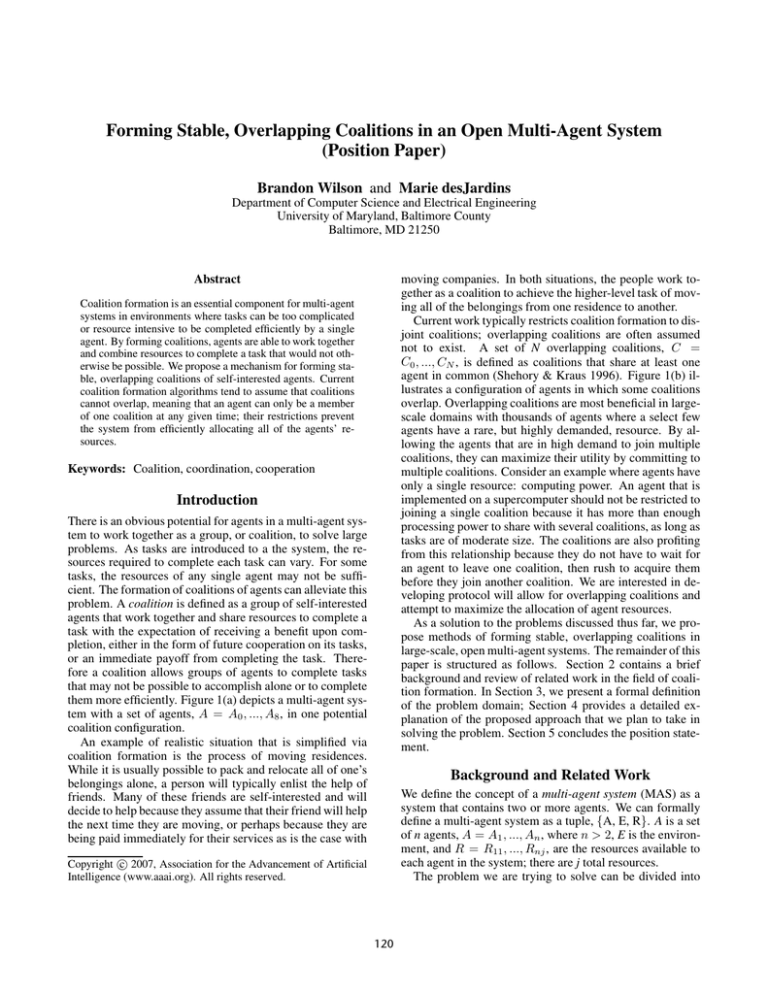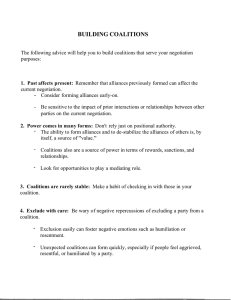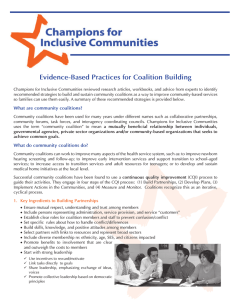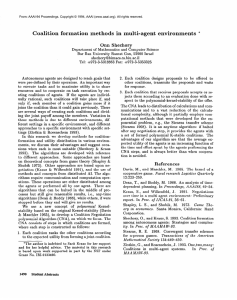
Forming Stable, Overlapping Coalitions in an Open Multi-Agent System
(Position Paper)
Brandon Wilson and Marie desJardins
Department of Computer Science and Electrical Engineering
University of Maryland, Baltimore County
Baltimore, MD 21250
moving companies. In both situations, the people work together as a coalition to achieve the higher-level task of moving all of the belongings from one residence to another.
Current work typically restricts coalition formation to disjoint coalitions; overlapping coalitions are often assumed
not to exist. A set of N overlapping coalitions, C =
C0 , ..., CN , is defined as coalitions that share at least one
agent in common (Shehory & Kraus 1996). Figure 1(b) illustrates a configuration of agents in which some coalitions
overlap. Overlapping coalitions are most beneficial in largescale domains with thousands of agents where a select few
agents have a rare, but highly demanded, resource. By allowing the agents that are in high demand to join multiple
coalitions, they can maximize their utility by committing to
multiple coalitions. Consider an example where agents have
only a single resource: computing power. An agent that is
implemented on a supercomputer should not be restricted to
joining a single coalition because it has more than enough
processing power to share with several coalitions, as long as
tasks are of moderate size. The coalitions are also profiting
from this relationship because they do not have to wait for
an agent to leave one coalition, then rush to acquire them
before they join another coalition. We are interested in developing protocol will allow for overlapping coalitions and
attempt to maximize the allocation of agent resources.
As a solution to the problems discussed thus far, we propose methods of forming stable, overlapping coalitions in
large-scale, open multi-agent systems. The remainder of this
paper is structured as follows. Section 2 contains a brief
background and review of related work in the field of coalition formation. In Section 3, we present a formal definition
of the problem domain; Section 4 provides a detailed explanation of the proposed approach that we plan to take in
solving the problem. Section 5 concludes the position statement.
Abstract
Coalition formation is an essential component for multi-agent
systems in environments where tasks can be too complicated
or resource intensive to be completed efficiently by a single
agent. By forming coalitions, agents are able to work together
and combine resources to complete a task that would not otherwise be possible. We propose a mechanism for forming stable, overlapping coalitions of self-interested agents. Current
coalition formation algorithms tend to assume that coalitions
cannot overlap, meaning that an agent can only be a member
of one coalition at any given time; their restrictions prevent
the system from efficiently allocating all of the agents’ resources.
Keywords: Coalition, coordination, cooperation
Introduction
There is an obvious potential for agents in a multi-agent system to work together as a group, or coalition, to solve large
problems. As tasks are introduced to a the system, the resources required to complete each task can vary. For some
tasks, the resources of any single agent may not be sufficient. The formation of coalitions of agents can alleviate this
problem. A coalition is defined as a group of self-interested
agents that work together and share resources to complete a
task with the expectation of receiving a benefit upon completion, either in the form of future cooperation on its tasks,
or an immediate payoff from completing the task. Therefore a coalition allows groups of agents to complete tasks
that may not be possible to accomplish alone or to complete
them more efficiently. Figure 1(a) depicts a multi-agent system with a set of agents, A = A0 , ..., A8 , in one potential
coalition configuration.
An example of realistic situation that is simplified via
coalition formation is the process of moving residences.
While it is usually possible to pack and relocate all of one’s
belongings alone, a person will typically enlist the help of
friends. Many of these friends are self-interested and will
decide to help because they assume that their friend will help
the next time they are moving, or perhaps because they are
being paid immediately for their services as is the case with
Background and Related Work
We define the concept of a multi-agent system (MAS) as a
system that contains two or more agents. We can formally
define a multi-agent system as a tuple, {A, E, R}. A is a set
of n agents, A = A1 , ..., An , where n > 2, E is the environment, and R = R11 , ..., Rnj , are the resources available to
each agent in the system; there are j total resources.
The problem we are trying to solve can be divided into
c 2007, Association for the Advancement of Artificial
Copyright Intelligence (www.aaai.org). All rights reserved.
120
A
A
1
A
satisfied. Here satisfaction is measured by a utility function that may vary from agent to agent. The protocol determines the set of coalitions without disclosing the individual agent preferences. This is distinct from other coalition
formation protocols in that it does not aggregate individual
agent utility functions to determine the coalitions. The secrecy of the agent preferences makes this algorithm applicable to an open system where information disclosure can
come at a high cost. This method, however, does not consider coalition overlap.
Rathod and desJardins (2004) studied the effect of coalition duration on the total tasks completed and total revenue
of a coalition. The domain of interest was a task oriented
domain and the system was populated with self-interested
agents that each possess one resource. A subset of the agent
population was selected to be team leaders. The team leaders
bid on tasks and formed coalitions to complete the tasks that
they were awarded. The results of the study showed that in
such a domain, the stable coalitions, coalitions that remained
together for longer than one task, accrued a larger overall
total revenue than dynamic, one-shot coalitions. This study
assumed that the system was closed and agents belonged to
only a single coalition. From this study, we draw the hypothesis that stable coalitions will also perform well when
overlap is permitted between coalitions and agents possess
multiple skills.
One of the major difficulties in the coalition formation
problem is that computing the optimal set of coalitions is
NP-complete (Gaston 2005). Sandholm et al. (1998) present
an coalition formation algorithm that is designed to form
coalitions for real-time applications. The algorithm models the problem as a search problem through the graph of all
possible coalition sets. The final solution may not be optimal, but it is guaranteed to be within a specific bound of the
optimal solution. The authors also derive an upper bound on
the running time of the algorithm that is acceptable for a real
time application.
Sandholm et al. (1998) decrease the running time further
by distributing calculations among the agents. To address
the possibility of malicious agents reporting incorrect results
of their portion of the calculation, checks are performed at
random by duplicating calculations to catch lying agents. A
significant punishment is applied to an agent that is caught
reporting false results and thus providing motivation to behave honestly.
8
3
A2
A
7
A4
A
A5
0
A
6
(a)
A
A
1
8
A3
A
2
A
7
A4
A
A5
0
A
6
(b)
Figure 1: Figure (a) represents a set of nine agents, A =
A0 , ..., A8 , in a multi-agent system are partitioned into a
set of three coalitions, C = C0 , C1 , C2 . In this instance,
C0 = A1 , A2 , A4 , C1 = A3 , A7 , A8 and C2 = A0 , A6 .
Agent A5 does not belong to a coalition at the time represented by this snapshot. (b) The same set of agents as in a
different coalition structure, with two overlapping coalitions
that share agent A4 .
two areas: disjoint coalition formation, and overlapping
coalition formation. A great deal of work has been performed on disjoint coalition formation, but forming coalitions that may overlap is relatively unstudied. The following
sections discuss the work that has been performed in each of
the individual areas.
Disjoint Coalition Formation
Overlapping Coalition Formation
The study of coalition formation has generally focused on
task-based multi-agent systems in which a set of agents are
posed with a series of tasks that must be completed. The
formation of coalitions allows the agents to complete tasks
that are impossible to complete alone within a given time
bound.
Caillou et al. (2002) describe a coalition formation protocol that is capable of determining a Pareto-optimal set of
coalitions, based on the assumption that each agent has a
set of preferences over the possible coalitions. This set is
considered Pareto-optimal because it has the characteristic
that in order to make any agent in the set more satisfied with
the assignment, at least one other agent will become less
Most of the work on coalition formation constrains each
agent to belong to only one coalition at a time. Allowing
agents to join multiple coalitions, or allowing coalitions to
overlap, proves to be useful in situations where some agents
are in possession of resources that are rare, yet in high demand. Agents with rare resources can maximize their profit
without hindering the other agents. It would hinder the system greatly if an agent had a common resource as well as
a rare resource and it belonged to a coalition that utilized
its common resource, but neglected the rare one. Figure
1(b) represents a set of agents that have been divided into
coalitions. Two of the coalitions share agent A4 as a com-
121
Membership Fees
mon member, presumably because it has resources that both
coalitions need, but are not possessed by any of the “free”
agents (in this case, A5 ).
Shehory and Kraus (1996) adapted the idea of overlapping
coalitions to a distributed problem solving domain. Their algorithm successfully utilizes resources in an efficient manner and maintains low computational complexity. This algorithm assumes that the agents in the system are all interested
in the success of the overall system. The algorithm will not
work in a system of self-interested agents because it does
not consider the possibility that agents may have incompatible goals, or an agent may be unreliable. Therefore, any
agent may decide to be uncooperative, destroying the whole
system.
For our model, we define a coalition as a group of selfinterested agents that are trying to maximize their profit. To
join a coalition, Ci , an agent must pay a membership fee that
is a function of the size of that coalition, f (|Ci |). The optimal function for this fee will be derived through experimentation. The nature of the function results in large coalitions
being costly to join, deterring these large coalitions from
ever existing. The membership fee is charged periodically
to ensure that agents do not remain in a coalition if it is no
longer useful. The fee also discourages agents from joining many coalitions since this can become non-profitable.
Agents are then encouraged to start coalitions so they can
avoid this costly fee when the coalitions are small. If at any
time an agent is not able to pay its membership fee, it is
forcefully removed from the coalition.
For the model to be robust against malicious agents, it
must reward agents that contribute rare resources to the
coalition and deter agents that contribute resources that are
already in surplus. This is accomplished by discounting
the membership fee by an amount proportional to the rarity of the resource. For a particular coalition, the rarity of
a resource Ri is measured as the percentage of coalition resources accounted for by Ri .
In addition to the membership fee, there is also an exit
fee, which is where our model differs from the conventional
business model. For an agent to leave a coalition, it must pay
a fee that is proportional to how reciprocative the agent has
been to the rest of the coalition. For example, an agent that
enters a coalition and uses its members to complete five of
its own tasks, but never assists the members with their tasks,
will face a large fee upon exiting the coalition; whereas another agent that has also used the coalition to complete five
tasks, but has also assisted the coalition members in completing five of their own tasks will be permitted to exit for
free. The reciprocative nature of an agent is also incorporated into the membership fee to prevent an agent from abusing a coalition forever.
Problem Domain
The domain we are modeling is task oriented and populated
with self-interested agents. The agents are assigned tasks
randomly; each task t is specified by R = r0 , ..., rn , which
is the set of resources required to complete the task. Each
task has an associated timeout and a payoff P (t) that designates the payment that will be received if the task is completed prior to expiring after a timeout. Maximizing the total payments received is assumed to be a general goal of all
agents in the system.
There is a task generator that randomly introduces tasks
and assigns them to an agent in the system. The agent is
then required to find a coalition that can accomplish the task.
If the combined resources of the agents in a coalition are at
least the same as those required by the task, then the task
can be completed. On the other hand, if the combined set
of resources of all agents in a coalition are more than a task
requires, then the surplus resources are being wasted. For
this reason that we allow agents to join multiple coalitions
to maximize their resource usage.
Agents in the system are motivated to achieve the highest profit possible; therefore, we model the agents as service providers. The services that the agents offer are the
resources that they possess. This provides two sources of
income in the system: a direct payoff for completing a task
and a payment for assisting another agent in completing a
task. As is the case in the real world, an agent is able to
set its own price for its services, allowing agents with rare
resources to maximize their profit. This also limits an agent
from overcharging for a common resource because there are
so many other providers.
Joining a Coalition
An agent that has been assigned a task that it can complete alone does not have any motivation to join a coalition.
Agents that have been assigned a task and need help to complete it are faced with deciding which coalition to join.
An agent will examine all of the coalitions that it currently
belongs to and if any of them have the resources to complete
the task, then the agent works with them. If the agent does
not belong to a coalition that can help or it does not belong
to any coalitions, then it examines the other coalitions in
the system. An agent that is interested in a coalition C can
request a list of agents and resources of each agent from any
member of C. The coalition that possesses the resources to
complete the task and offers the lowest membership fee is
selected. In the case that the agent still does not find a valid
coalition, it starts a coalition of its own. Once an agent is
part of a coalition or starts a coalition, it can recruit members
by advertising open tasks to “free” agents. Despite starting
a coalition, the agent periodically performs a check of the
Proposed Solution Approach
We propose a solution to the problem of forming overlapping, stable coalitions of agents based on the membership
fees and benefits business model. Many wholesale retailers
utilize this model to maintain their customers’ loyalty. These
businesses sell products in bulk at a reduced rate as a benefit to those who purchase a membership. Those who do not
wish to become members can still shop at other stores that
do not offer the same benefits, but also do not require a paid
membership.
122
coalitions to see if any have grown to offer a valid set of
resources. If the agent finds a coalition during one of these
periodic checks then it can dismantle the coalition it formed
without penalty.
Gaston, M. 2005. Organizational Learning and Network
Adaptation in Multi-Agent Systems. Ph.D. Dissertation,
University of Maryland, Baltimore County.
Rathod, P., and desJardins, M. 2004. Stable Team Formation Among Self-Interested Agents. In In Working Notes
of the AAAI Workshop on Forming and Maintaining Coalitions in Adaptive Multiagent Systems.
Sandholm, T.; Larson, K.; Andersson, M.; Shehory, O.;
and Tohme, F. 1998. Anytime Coalition Structure
Generation with Worst Case Guarantees. Arxiv preprint
cs.MA/9810005.
Shehory, O., and Kraus, S. 1996. Formation of overlapping coalitions for precedence-ordered task-execution
among autonomous agents.
Membership Benefits
Members of a coalition gain several benefits, some of which
are implicit to our mechanism. When an agent enlists the resources of another agent in the same coalition, it is supplied
the resources at a discounted cost, where the discount factor,
α, is a percentage (in the range [0.0 - 1.0]).
If an agent is assigned a task that it cannot complete with
agents in its coalition, then it can obtain information about
agents that could be helpful in the task from other agents
in the same coalition. To encourage agents to cooperate
with these queries, their responses contribute to reciprocity
among the coalition and thus reduce their exit fee.
The membership fees are another potential benefit of joining a coalition. The membership fees that are paid for a
coalition membership are distributed among the members of
the coalition evenly. This provides a motivation to join small
coalitions instead of creating oversized coalitions.
Disbanding and Reforming of Coalitions
The proposed mechanism will form stable coalitions in the
presence of similar tasks. Tasks are considered similar if
they have approximately the same resource requirements.
Agents form coalitions that have a resource pool that is capable of accomplishing a given type of task. If the task distribution alters significantly, then the agents in the coalitions
will stop receiving benefits from their coalitions and will ultimately exit their current coalitions – which are no longer
making profitable returns – reforming in coalitions that can
perform the new tasks. As a result, we believe that the mechanism we propose will gracefully disband coalitions that no
longer offer significant benefits and reform coalitions that
are a more efficient allocation of the agents’ resources.
Conclusion
Coalition formation is a well-studied area of multi-agent
systems, but most of the work has focused on disjoint coalition formation that can result in an efficient allocation of
resources. Overlapping coalitions have been overlooked in
much of the existing research, but they are crucial in environments where agents possess multiple resources and wasting those resources is very costly.
We have presented our ideas on forming coalitions that
result in maximizing the allocation of resources. Our ideas
also address the problem of self-interested agents unreliability of reciprocating actions..
References
Caillou, P.; Aknine, S.; and Pinson, S. 2002. A MultiAgent Method for Forming and Dynamic Restructuring of
Pareto Optimal Coalitions. Proceedings of the First International Joint Conference on Autonomous Agents and
Multi-Agent Systems: Part 3 1074–1081.
123







